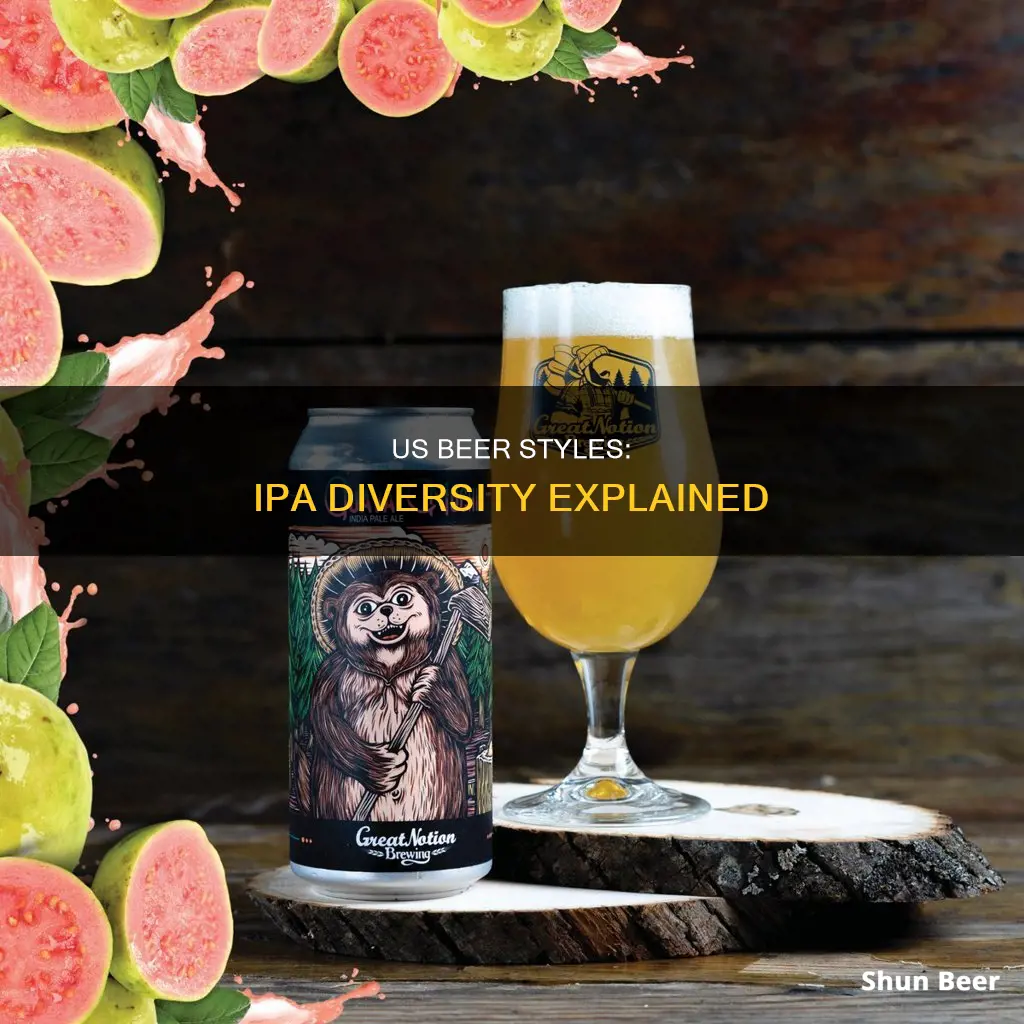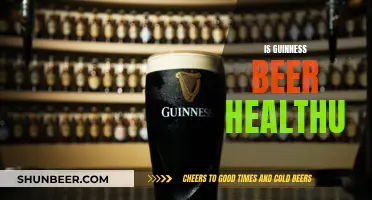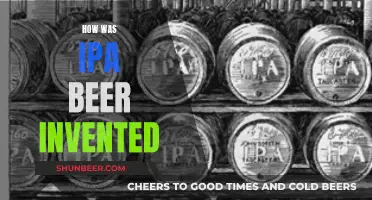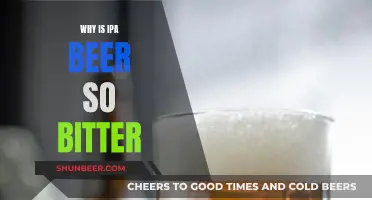
India Pale Ale (IPA) is a hoppy beer style that originated in Britain. The style was first created to survive the long journey from London to Calcutta, India, where it gained popularity among East India Company traders. The addition of hops helped preserve the beer during its voyage, and the resulting bitter and strong pale ale was well-suited to the hot Indian climate. Over time, the IPA evolved and spread to other parts of the world, including the USA, where it sparked a craft beer revolution. American brewers revived old recipes while adding new styles of hops, leading to the creation of various IPA styles that continue to evolve and gain popularity today.
What You'll Learn

The IPA's origins
The India Pale Ale (IPA) was first created in Britain for export to India. In the late 18th century, George Hodgson of the Bow Brewery in East London began sending his pale ale to India with extra hops and a higher alcohol content. The hops and alcohol helped preserve the beer during its long sea journey from England to India. This created a bitter and strong pale ale that was more refreshing in the hot Indian climate compared to the dark ales and porters popular in London.
By the 1760s, breweries learned that adding extra hops helped fortify beers for the voyage to warmer climates. The beer being exported wasn't much stronger in alcohol content, however. While Hodgson was not the first brewer to come up with the concept, he was the first to achieve a large amount of distribution in India. The Bow Brewery was popular with East India Company traders due to its proximity to the East India Docks and Hodgson's liberal credit line of 18 months.
The East India Company eventually sought new brewing partners, and found them in Burton upon Trent, where brewers had lost their valuable export markets in Russia after it was banned by the Tsar. The Allsopp, Bass and Salt breweries improved on Hodgson's recipe for hopped pale ale, and took over the Indian market.
By the early 19th century, "pale ale prepared for the India market" was gaining in popularity as exports and hopping levels increased. The first known recorded mention of the phrase "India Pale Ale" came in 1835 in an edition of the Liverpool Mercury. Beer drinkers in England got to taste this export style of pale ale by the 1830s, and by 1840, India Pale Ale became one of England's best-selling beers.
The popularity of India Pale Ales waned in England by the start of the 20th century as new styles entered the market and taxes on higher-gravity beers increased. The style was revived in the United States during the craft beer revolution of the 1970s and 1980s, with brewers adding new styles of hops and increasing the alcohol content to create the various styles of IPA available today.
Guinness Beer: Carcinogen Concerns and Consumption
You may want to see also

The rise of craft breweries
Craft beer production in the U.S. has reached unprecedented levels, and while the major beer producers still dominate the industry's sales, small independent craft breweries have been steadily climbing up the list of top breweries in terms of beer production volume. In 2017, 40 out of the top 50 breweries in the U.S. were craft breweries. This trend is not limited to a few states, as almost 400 counties in the U.S. had at least one brewery in 2016 that did not exist in 2012. The states with the highest craft beer production are Pennsylvania and California, each producing over 3 million barrels annually.
The success of craft breweries can be attributed to various factors, including their ability to utilise non-traditional ingredients, engage with their customers and communities, and sponsor local events. Additionally, the Brewers Association, a trade group for craft breweries, has played a crucial role in promoting and protecting small and independent craft brewers. They introduced the Independent Craft Brewer Seal to help consumers identify independent craft breweries and acquired breweries.
The craft beer movement in the U.S. has also influenced drinking trends and shaped the beer industry. For example, in 2014, IPA became the leading craft style above pale ale or amber ale. The popularity of craft beer has led to a shift in drinking preferences, with consumers seeking out unique and flavourful beers, contributing to the overall growth of the craft beer industry.
Guinness Beer's Dark Mystery: A Stout Conundrum
You may want to see also

The IPA's unique flavour profile
The India Pale Ale (IPA) is a hoppy beer style within the broader category of pale ale. The unique flavour profile of IPAs is characterised by its bitterness, resulting from the higher-than-average amount of hops used in brewing. However, the bitterness of IPAs is not overwhelming, and it is well-balanced by malt in the beer.
IPAs exhibit a wide range of flavour profiles, from fruity and citrusy to earthy and piney. The fruity flavours can be further described as tropical, with notes of mango, tangerine, passionfruit, and orange. Citrus flavours include grapefruit and lemon. The earthy notes in IPAs often resemble pine or grass.
The variety in the flavour profiles of IPAs is due to the different types of hops used, the timing of their addition, and the specific brewing techniques employed. For instance, the New England style IPA, also known as the Hazy IPA, is unfiltered and has extremely low bitterness due to the use of hop blends that lend intense, fruity flavours. On the other hand, the American or West Coast IPA is hop-forward, with medium to high bitterness and citrusy, floral, and piney notes.
The bitterness of an IPA can be determined by referring to its IBU (International Bitterness Units) ranking, with most IPAs ranging from 40 to 60 on this scale.
The higher alcohol content of IPAs, often a result of the increased malt used to balance the hops, also contributes to their flavour profile. The higher alcohol content can lend a boozy flavour to the beer, and the minimum ABV for a Double IPA is 7.5%, with some IPAs climbing as high as 11%.
The unique flavour profile of IPAs has made them extremely popular, dominating shelves, bar tops, and beer competitions. The American IPA, in particular, has ruled as the king of craft beer for over a decade, and its popularity continues to grow.
Guinness: Lightest Beer or Darkest Brew?
You may want to see also

The IPA's many varieties
The IPAs Many Varieties
India Pale Ale (IPA) is a hoppy beer style within the broader category of pale ale. The IPA is the most popular craft beer style in America and the world. The American India Pale Ale is as popular now as it was a decade ago.
The IPA was invented in Britain. British sailors needed beers that could survive the long, arduous trip from London to Calcutta, India. Hops have preservative qualities, so English brewers loaded their brews with them. The popular origin story is that in the late 18th century, George Hodgson, a brewer at the Bow Brewery in East London, began sending his pale ale to India packed with extra hops and an increased alcohol content. However, this is a simplified version of what really happened. By the 1760s, breweries learned that adding extra hops to all of their beers helped fortify them for the voyage to warmer climates.
The first American IPAs were created on the West Coast with new hop varieties, such as Cascade and Chinook. These beers are very hop-forward with piney, floral, and citrus notes and a strong bitterness. More recently, East Coast IPAs have arrived from breweries in New England that have balanced the strong hoppiness with an equally strong malt component.
The hottest style of IPA currently on the market is the New England IPA, also known as the Hazy IPA. The haze comes from the fact that they are unfiltered and often include the addition of wheat or oats. New England IPAs have extremely low bitterness and a citrus flavor that might remind you of drinking a glass of juice.
Another style of IPA that has become trendy is the Milkshake IPA or Lactose IPA. These IPAs add lactose, as well as oats, fruit, and/or vanilla during the brewing process. The lactose gives the beer a sweeter taste and a creamy mouthfeel.
The Sour IPA, while not yet officially defined by the Brewers Association, is widely understood as a New England IPA brewed with lactobacillus—a kind of yeast used in the souring process. This, along with the use of fruits, adjuncts like vanilla and lactose, and sometimes even barrel aging, inject this style with tart, fruity, funky flavors that are still rooted in hops.
The Farmhouse IPA is an ancient style that comes from the farmers of Europe. They often didn't have access to beers available in the big trade cities and ports, so they brewed this rustic style using the same grains and fruits grown on the farm. The Farmhouse IPA is still brewed in the same tradition, but now, brewers load the beers with heaps of fruity, potent hops to amplify the style's flavors.
The Belgian IPA is brewed with Belgian yeast and European malts to give it a classically malty, caramelly, fruity flavor that's unique to Belgian beers. But, just like the Farmhouse IPA, it's loaded with hops to amplify the beer's character and inject it with a bitter bite to round out the flavors.
The Red IPA, also called an Imperial Red Ale, is inspired by the Irish Red Ales from the Old Country. These malty, caramel-laced, slightly fruitier brews are harder to find in the vast IPA scene, but they still hold a place in American craft fans' hearts. While still as malty as the Red Ales of Europe, Red IPAs showcase American hops to bring a welcome bitterness that rounds out the beer's notes of toffee, roasted barley, and citrus.
Session IPAs are IPAs that have the classic hop-forward flavor but with an alcohol content more in line with popular American lagers. With an ABV of around 5%, you can enjoy multiple beers in one sitting or session.
Double or Imperial IPAs are essentially the same thing: IPAs with a higher hop concentration. To balance all that hop flavor, the brewer uses more malt, which results in a higher ABV (usually over 7%).
Triple IPAs are characterized by higher hop flavors and higher alcohol content, with alcohol content usually over 10% ABV.
Guinness Beer: Alkaline or Acidic Drink?
You may want to see also

The IPA's popularity
The India Pale Ale (IPA) is the most popular craft beer style in America and the world. The style was first created in Britain, where English sailors needed a beer that would survive the long journey from London to Calcutta, India. Hops have preservative qualities, so English brewers added extra hops to their brews. The result was a bitter and stronger pale ale that was more refreshing in the hot Indian climate.
The popularity of IPAs in England waned in the early 20th century as new styles entered the market and taxes on higher-gravity beers increased. However, the style was revived in America during the craft beer revolution of the 1970s and 1980s. Brewers in America revived the original recipes created 150 years earlier in England while adding new styles of hops. This led to the creation of American IPAs, which can be divided into two main styles: West Coast IPA and East Coast IPA.
The first American IPAs were created on the West Coast with new hop varieties such as Cascade and Chinook. These beers are very hop-forward with piney, floral, and citrus notes and strong bitterness. More recently, East Coast IPAs have emerged from breweries in New England that have balanced the strong hoppiness with a strong malt component.
The New England IPA, also known as the Hazy IPA or East Coast IPA, is currently the hottest style of IPA on the market. These beers are unfiltered and often include the addition of wheat or oats, resulting in a hazy appearance. New England IPAs have extremely low bitterness and a citrus flavor that might remind you of drinking a glass of juice.
The Milkshake IPA, or Lactose IPA, is another style of IPA that has become trendy recently. These IPAs add lactose, oats, fruit, and/or vanilla during the brewing process, giving the beer a sweeter taste and a creamy mouthfeel.
The IPA is popular because it is synonymous with the craft beer revolution. It is the ultimate status symbol in the craft community, and its bold and mysterious nature appeals to beer drinkers. Additionally, the various styles of IPA, such as the West Coast and East Coast variations, offer something for everyone.
Guinness Beer's Carb Content: A Detailed Breakdown
You may want to see also
Frequently asked questions
The IPA is a versatile style of beer that lends itself to experimentation with flavours, ingredients and brewing processes. The craft beer revolution in the USA has seen brewers seeking out old beer styles and giving them a modern twist, and the traditional IPA style is well-suited to the intense flavour and aroma of American hops.
English IPAs tend to be maltier, with notes of biscuit and toffee and a lower ABV. American IPAs are hop-forward, with piney, citrusy, floral flavours and a stronger bitterness.
A New England IPA (also known as a Hazy IPA or a Juicy IPA) is unfiltered, with extremely low bitterness and a citrus flavour. They often have a smooth consistency and a hazy appearance.
A Milkshake IPA (also known as a Lactose IPA) is brewed with milk sugar (lactose) to give it a creamy, smoothie-like quality. Fruit or vanilla may be added to enhance the pillowy mouthfeel.
A Session IPA is a modern twist on the traditional IPA, with a lower ABV that allows drinkers to consume multiple beers in one sitting.







